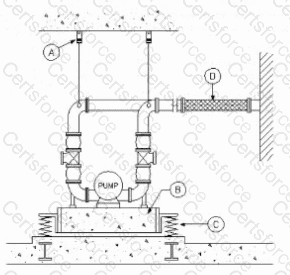Understanding the Diagram
The image shows a pump installation detail with various vibration and alignment control devices:
A — Typically a pipe hanger or suspension support to reduce strain on piping.
B — Likely a flexible electrical conduit (for pump motor connection).
C — Spring vibration isolators under the pump base to prevent vibration transmission into the building structure.
D — A flexible pipe connector (also called a flex connector or braided flexible coupling).
Purpose of Flexible Pipe Connectors
Flexible pipe connectors (D in the diagram) are designed to:
Absorb minor misalignment between connected piping systems.
Reduce stress on pump flanges due to thermal expansion, settlement, or installation tolerances.
Isolate vibration from the pump so that it is not transmitted along rigid piping to the building structure.
This makes them essential in mechanical systems where pumps, chillers, or other vibrating equipment connect to rigid building piping.
Why Other Options Are Incorrect:
A. Pipe hangers/supports — Maintain alignment and support vertical loads but do not allow for misalignment or vibration isolation in the same way as flexible connectors.
B. Electrical conduit/flexible connection — Relates to electrical supply flexibility, not piping alignment.
C. Spring vibration isolators — Isolate vibration from equipment to the floor but do not address piping misalignment.
NCARB ARE 5.0 PDD Study Guide References:
Content Area: Integration of Building Materials & Systems — Mechanical Systems Coordination
Source References:
Mechanical and Electrical Equipment for Buildings (MEEB) — Chapter on Vibration Isolation & Pump Installation
Architectural Graphic Standards — Flexible Connector & Piping Details
Key Point: Flexible connectors at pumps and equipment protect against misalignment, vibration, and stress transfer to the piping system.

Submit